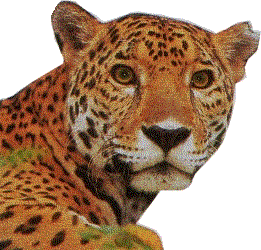Introduction
Jaguar
Leopard
Panther
Snow leopard
Survey
Poems
Pat
Safari
Link
XJ220


Guestbook Disclaimer Contact Home

Jaguar (Panthera
onca)
"Jag War" - "the flying hunter"
Habitat:
~ in the south of the USA, Central America and in the rain
forests of South America, but mostly at the edge of the
forest and in the savannah. Jaguars usually live in areas
that are well supplied with woods, shrubs or high grass
and - most importantly - water.
Unfortunately the number of these beautiful cats decreases
due to deforestation of the rain forest, in some parts
entire subspecies have vanished.
Fur:
~ Jaguars have yellow to reddish-brown fur with black
rosettes, which contain up to two pots. (to compare:
leopards have rosettes without spots). These rosettes
merge into stripes on legs and neck. The underside of the
neck to the belly is ochre to white, as are the insides of
the legs.
~further, there are black variations of the jaguar (more
to find under "panthers")
Proportion:
Length 110 to 180 cm (measured without the tail)
Shoulder height of 70 to 80 cm
Tail length 50 to 60 cm
Weight female 45 to 90 kg
Weight male 55 to 100 kg
Physique:
~ Jaguars are rather sturdy and strongly built, yet still
they are very lithe and agile. Due to their massive
appearance one tends rather to thinking that they live on
the ground, which in fact is gernerally correct. However,
they are gifted with exzellent climbing skills, which
makes them in trees at home just as leopards.
Maximum Age:
~the maximum age of jaguars is about 12 years, in
captivity up to 22. - rare in free nature.
Reproduction:
~ under normal conditions the jaguar is a loner, but
exceptions always exist.
~ the mating time is throughout the year. The female is
pregnant between 92 to 100 days. A litter consists of 1 to
4 cubs - and these stay with their mother till the own
sexual maturity (about 2 years).
Diet/hunt:
~ the table of the jaguar is richly set. Its food pallet
begins with small animals such as frogs, fish, lizards,
continues to go over snakes, turtles, cayman, iguana,
armadillos, smaller crocodiles and deer. Apes, ground
breeding birds and various large mammals and ends with
avocados. Sometimes it hunts also a few pets like dogs.
(they are an easy prey).
~ If you've ever seen a jaguar hunt, you would recognize
that it is a fast short-distance runner. It patiently
waits lying in ambush for several hours directly on the
often used paths of its prey, to strike within the blink
of an eye. One powerful wipe with the paw kills the booty,
or at least tears it onto the ground. A deadly neck bite
or a bite into the head basis completes the hunt. In order
to hunt fish, it waits in shallow waters for fish and
strikes it directly from the water onto the dry. Jaguars
carry their prey to a safe place prior to eating it. They
bury the rest of the meal secretly. Their most important
"tools" are their fangs, which are able to split a skull
or a shell easily.
|
Class: |
Mammalia (Mammals) | |
| Order: | Carnivora (Carnivore) | |
| Family: | Felidae (Cats) | |
| Subspecies: | Pantherinae | |
| Species: | Panthera (Big cats) | |
| Sort: |
Panthera onca (Jaguar)/approx. 8 subspecies |


